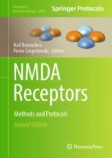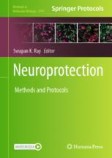Search
Search Results
-
Behavioral Assays Dissecting NMDA Receptor Function in Zebrafish
Zebrafish are a powerful system to study brain development and to dissect the activity of complex circuits. One advantage is that they display...
-
Expression and Purification of Mammalian NMDA Receptor Protein for Functional Characterization
N-methyl-D-aspartate (NMDA) receptors are critical for brain function and serve as drug targets for the treatment of neurological and psychiatric...
-
Analysis of Functional NMDA Receptors in Astrocytes
Neuronal N-methyl-D-aspartate (NMDA) receptors are well known for their pivotal role in memory formation. Originally, they were thought to be...
-
Generation of Rare Human NMDA Receptor Variants in Mice
The analysis of rare NMDAR gene variants in mice, coupled with a fundamental understanding of NMDAR function, plays a crucial role in achieving...
-
Estimating the Ca2+ Block of NMDA Receptors with Single-Channel Electrophysiology
In vertebrate central neurons, NMDA receptors are glutamate- and glycine-gated ion channels that allow the passage of Na+ and Ca2+ ions into the cell...
-
Characterizing Functional Contributions of Specific GluN2 Subunits to Individual Postsynaptic NMDAR Responses Using Biophysical Parameters
The NMDAR is a heterotetramer composed of two GluN1 subunits and two GluN2 and/or GluN3 subunits, with the GluN2 subunits exhibiting significant...
-
Understanding Actin Remodeling in Neuronal Cells Through Podosomes
Cytoskeletal dysregulation forms an important aspect of many neurodegenerative diseases such as Alzheimer’s disease. Cytoskeletal functions require...
-
Role of Network Pharmacology in Prediction of Mechanism of Neuroprotective Compounds
Network pharmacology is an emerging pioneering approach in the drug discovery process, which is used to predict the therapeutic mechanism of...
-
Quantitative Measurement of Tau Aggregation in Genetically Modified Rats with Neurodegeneration
Animal models of neurodegenerative diseases have helped us to better understand the pathogenesis of neurodegenerative diseases. However, recent...
-
Astrocyte Activation and Drug Target in Pathophysiology of Multiple Sclerosis
Multiple sclerosis (MS) is a neurodegenerative disease, which is also referred to as an autoimmune disorder with chronic inflammatory demyelination...
-
Impacts of Omega-3 Fatty Acids, Natural Elixirs for Neuronal Health, on Brain Development and Functions
Omega-3 fatty acids play a seminal role in maintaining the structural and functional integrity of the nervous system. These specialized molecules...
-
Detection and Characterization of Apoptosis-Related Proteins in Hippocampal Neurodegeneration: From mRNA Expression to Protein Quantification
The involvement of apoptosis in neurodegeneration can be detected by quantifying the apoptotic proteins in hippocampal lysate. Apoptosis can occur...
-
Fecal Microbiota Transplantation in Amyotrophic Lateral Sclerosis: Clinical Protocol and Evaluation of Microbiota Immunity Axis
The fecal microbial transplantation (FMT) is a therapeutic transplant of fecal microbiota from healthy donors to patients. This practice is aimed at...
-
Rat Model of Middle Cerebral Artery Occlusion
Stroke is the third-leading cause of death and the leading cause of acquired adult disability worldwide. Several ischemic stroke models are currently...
-
Imaging and Assay of the Dynamics of Cytotoxic Huntingtin (HTT) Protein Aggregates Regulated by lncRNAs
Huntington’s disease (HD) pathogenesis involves deregulation of coding and noncoding RNA transcripts of which the involvement of long noncoding RNAs...
-
iDISCO Tissue Clearing Whole-Brain and Light Sheet Microscopy for High-Throughput Imaging in a Mouse Model of Traumatic Brain Injury
Immunolabeling-enabled imaging of solvent-cleared organs (iDISCO) (Renier N, Wu Z, Simon DJ, Yang J, Ariel P, Tessier-Lavigne M, Cell 159:896–910,...
-
Quantification of Neuronal Dendritic Spine Density and Lengths of Apical and Basal Dendrites in Temporal Lobe Structures Using Golgi-Cox Staining
The objective of this chapter is to provide an overview of the methods used to investigate the connectivity and structure of the nervous system....
-
Targeted Modification of Epigenetic Marks Using CRISPR/dCas9-SunTag-Based Modular Epigenetic Toolkit
The epigenome, consisting of chemical modifications to DNA and histone proteins, can alter gene expression. Clustered regularly interspaced short...
-
Weight-Drop Method for Inducing Closed Head Diffuse Traumatic Brain Injury
Traumatic brain injury (TBI) is one of the foremost causes of disability and death globally. Prerequisites for successful therapy of disabilities...
-
Heart Rate Variability as a Biomarker for Electrical Vagus Nerve Stimulation
Electrical vagus nerve stimulation (eVNS) comprises an array of non-pharmacologic techniques used to stimulate afferent fibers of the vagus nerve....
